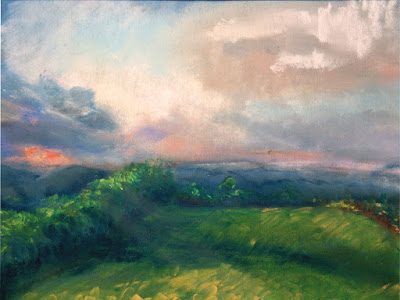Just as plein air teaches you to paint fast and loose, studio painting teaches you to paint deeper.
 |
| Not every day of that year was cold. Pastel, by Carol L. Douglas. |
When I finally decided to master plein air painting, I made the commitment to paint outdoors every day for one year, regardless of weather. That didn’t include Sundays, so it added up to 313 canvases painted in every kind of weather. For some reason, the worst days are the most memorable: the wind howling off the water at Ontario Beach Park, my oil paint freezing into stodge in a vineyard, or my car battery dying on a lonely country road. That was before cell phones, so I took a long, cold trudge to a nearby farmhouse to ask for a jump.
I’m sure there were many more pleasant days during that year, but they’re not stuck in my memory. Outdoor painters, like other adventurers, love to collect war stories.
 |
| The most memorable thing about this painting is that my car battery died from the cold. Oil, by Carol L. Douglas. |
That year was an essay in mastery. I learned to paint in a more direct way. I mastered the three- to six-hour painting. And I developed the discipline of working through the “I don’t feel like it” moments.
Since then, I’ve done some similar, shorter challenges. I devised them for myself to answer specific problems. For example, when I realized that I misunderstood tree structure, I painted a tree every day. And when I was hampered by circumstances from doing large paintings, I did one-hour still lives each day.
This is the season of new beginnings. For some of us, that will include painting-a-day challenges. If you’ve never done one, I encourage you to try it.
 |
| This fast sketch is a personal favorite. It hangs in my home. Oil, by Carol L. Douglas. |
I won’t be joining you. Been there, done that.
Daily paintings come at the cost of finishing larger canvases, which also have their place in one’s artistic development. We tend to shy away from approaching the last-minute business of finishing. That means asking, intentionally, how refined we want the ending to be. Until you bring a painting or two to that stage of high polish, you’re suffering a case of arrested development.
There’s a trope that drives me nuts: “Not one more brushstroke! You’re done!” We’ve gotten so used to the fast painting that we sometimes forget how to develop slow ones. Not stepping beyond that arbitrary finish-line retards our development. At some point, we need to be able to tell deeper stories than are possible in a field sketch.
 |
| And then there were days that were just golden. Pastel, by Carol L. Douglas. |
Just as plein airteaches you how to work fast and loose, studio painting teaches you how to go deeper. I like nothing better than haring off to a new place with my paints. But there are times when I need to work slowly.
One of the joys of living in the far north is that the calendar tells you when that’s appropriate. When the wind is howling and the snow blowing, I know it’s time to focus on studio painting. Mother Nature says so.
A note to New York muralists: Believe in Syracuse is offering a $20,000 stipend to paint a mural on a West End building. For more information, see
here.










